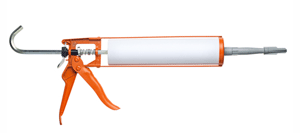Plugging the Air Leaks in Your Home: Caulk Basics
Plugging the Air Leaks in Your Home: Caulk Basics
 The caulking gun is as familiar to most homeowners as the screwdriver and paintbrush. However, its applications are far more varied than simply filling that gap around the sink. With temperatures in the Los Angeles basin only dipping below the seventies for a couple of months a year, air leakage can be expensive. Warm, humid air entering your home competes with the HVAC system, increasing fuel consumption and hiking bills. Used to seal the cracks and air-entry points that pepper most homes, the humble caulking gun can save a great deal of money. It’s time to polish up on some caulk basics.
The caulking gun is as familiar to most homeowners as the screwdriver and paintbrush. However, its applications are far more varied than simply filling that gap around the sink. With temperatures in the Los Angeles basin only dipping below the seventies for a couple of months a year, air leakage can be expensive. Warm, humid air entering your home competes with the HVAC system, increasing fuel consumption and hiking bills. Used to seal the cracks and air-entry points that pepper most homes, the humble caulking gun can save a great deal of money. It’s time to polish up on some caulk basics.
- Definition.
- Types.
- 1. Butyl rubber seals most disparate materials, including concrete, glass, metal, plastic and wood, can shrink from 5 to 30 percent of application volume, and exhibits good adhesion.
- 2. Latex fills cracks and nail holes in tile, plaster, glass and plastic; shrinkage is from 5 to 10 percent, and adhesion is excellent.
- 3. Household silicone seals metal joints, tiling and porcelain-like surfaces, exhibits little or no shrinkage, and has excellent adhesion. Construction-grade silicone seals most dissimilar building materials, including wood, stone and brick (shrinkage and adhesion are identical).
- Our goal is to help educate our customers in the greater Los Angeles, California area about energy and home comfort issues (specific to HVAC systems).
Caulk is a viscose, thick-but-flowing material that’s typically used to seal cracks, gaps and joints that are less than a quarter-inch wide. While some caulks remain extremely flexible even after curing, all are suitable only for use between stationary building components.
There are a number of different caulk varieties, each with specific characteristics and applications. Some even change color, being white when applied — to avoid hit-and-miss mistakes — then drying clear so as to be unobtrusive.
Obviously, easily-accessible gaps and cracks make fun and rewarding DIY sealing projects. Sadly, though, caulk basics can’t explore the many strengths, properties and prices on the market. Further, homeowners are unlikely to be able locate and resolve all illicit points of air ingress. It’s also very important for your family’s health to ensure that indoor air quality remains optimal; adequate ventilation must be left after sealing. Air-Tro Inc. are your local air sealing experts. Arrange a free consultation to build on the caulking basics.
Image courtesy of Shutterstock
